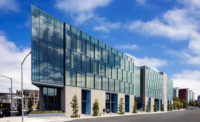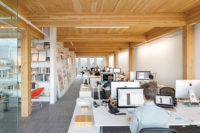The process for mass-timber-construction permitting is about to become streamlined, thanks to changes to the International Building Code (IBC) set to take effect in 2020. In December, the International Code Council passed 14 code changes relating to mass timber construction that, pending validation of the vote, would be included in the 2021 IBC. (The code is revised every three years.) Among the changes is the creation of three types of construction that set new allowable heights and fire-safety ratings for wood buildings.
The current code sees buildings in mass timber, including cross-laminated timber, as outliers from existing categories, and requires performance-based design for permitting processes. The proposed changes would both define mass timber construction and create three new categories for it, dealing with mass timber that is protected with noncombustible materials, partially exposed, and unprotected, with maximum heights of 18, 12, and nine stories, respectively. Allowable areas for mass timber structures would also be increased over current allowances for heavy timber construction.
Thomas Robinson, founder of Portland, Oregon–based LEVER Architecture, explains the potential of these code changes from his office in a mass-timber building his firm designed, Albina Yard: “With this new code, you could say, ‘If I follow these guidelines, I’m pretty confident that I’ll be able to get a permit.’ That has a huge impact on how owners will think about investing in these types of buildings,” he says, “and on strengthening the national supply chain, because people will be comfortable investing in technology and in building new [mass-timber] plants.”
Robinson and his team at LEVER are well versed in timber construction, as co-winners of the U.S. Tall Wood Building Prize for their 12-story project, Framework. (The other winner was 475 West 18th by SHoP Architects; both are currently on hold for financial reasons.) The LEVER team conducted around 40 tests for fire safety, acoustic performance, and structural performance to gain permitting for Framework, which was the first wood high-rise to win such approval in the United States. Robinson says his firm’s work highlights the opportunity that code changes present to architects, who will no longer face the same rigors of testing his team encountered.
Tentative approval of the code-change proposals in the spring is likely. Final approvals will occur in October, with the 2021 version of the IBC to be published at the end of 2020.






Post a comment to this article
Report Abusive Comment